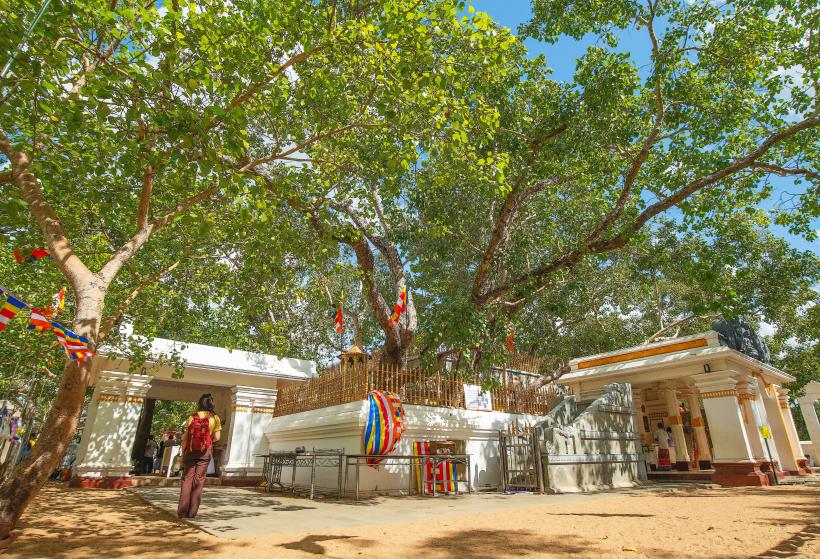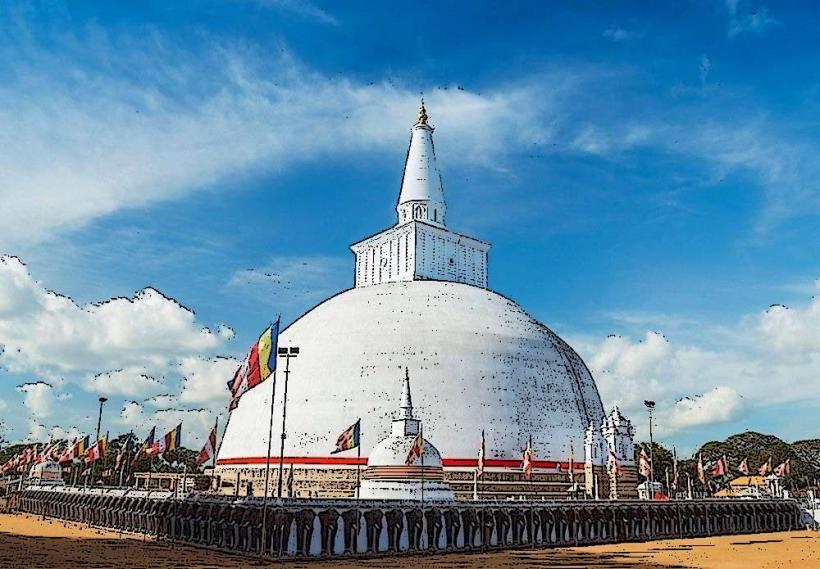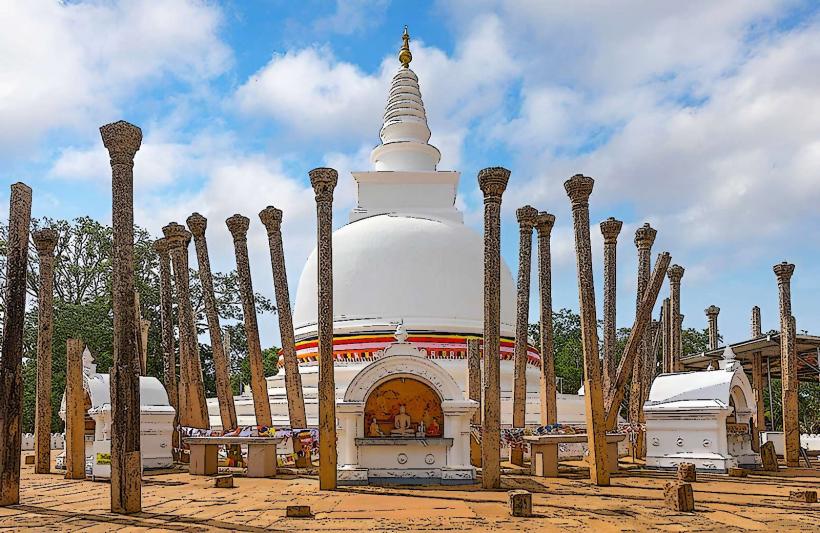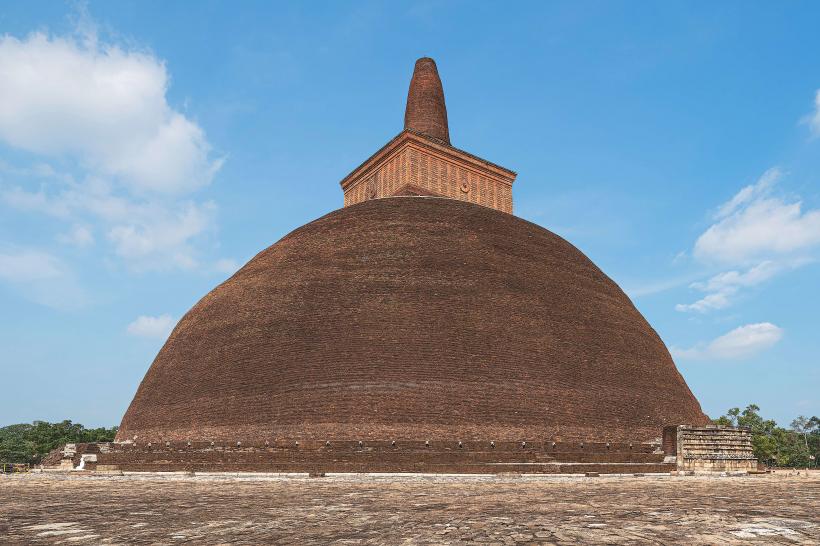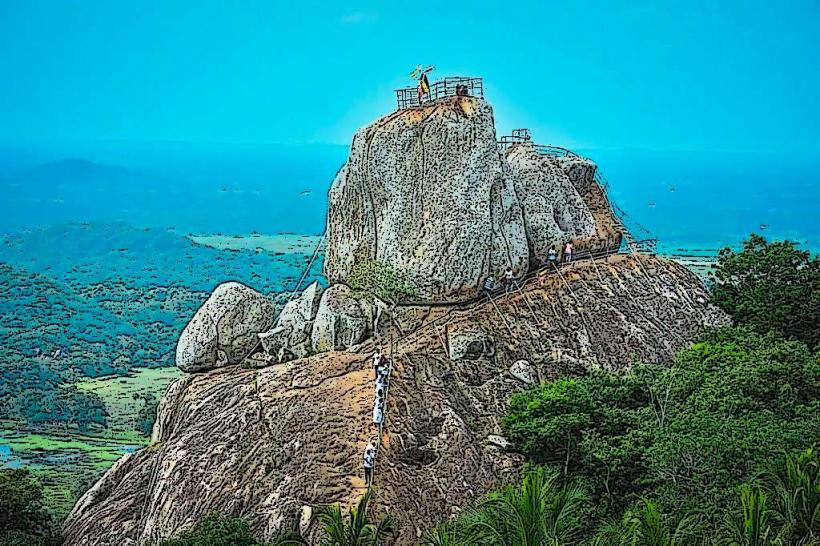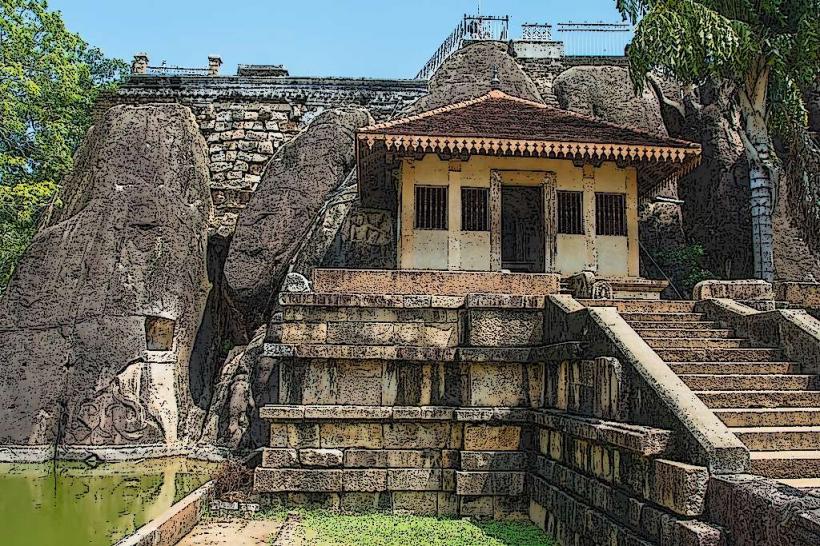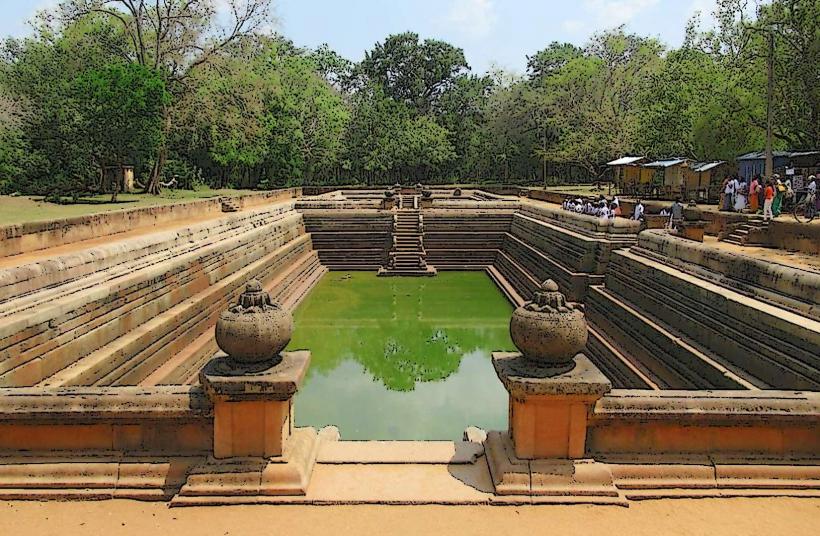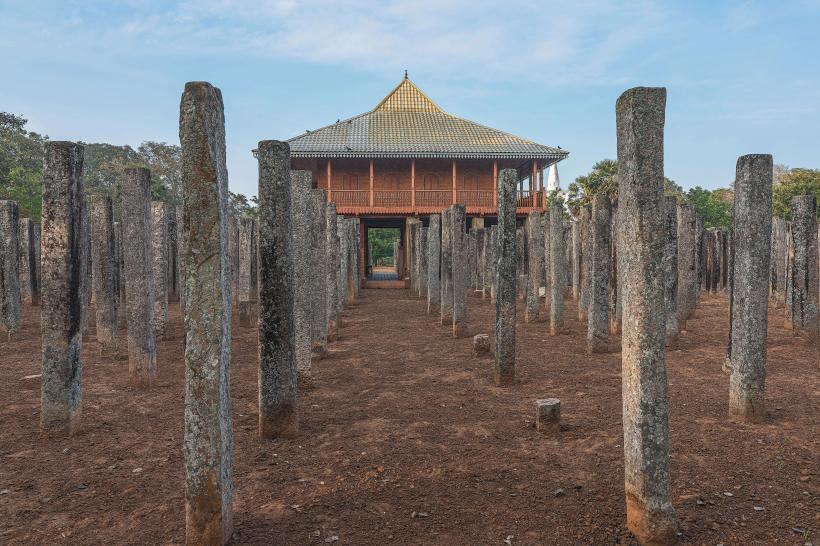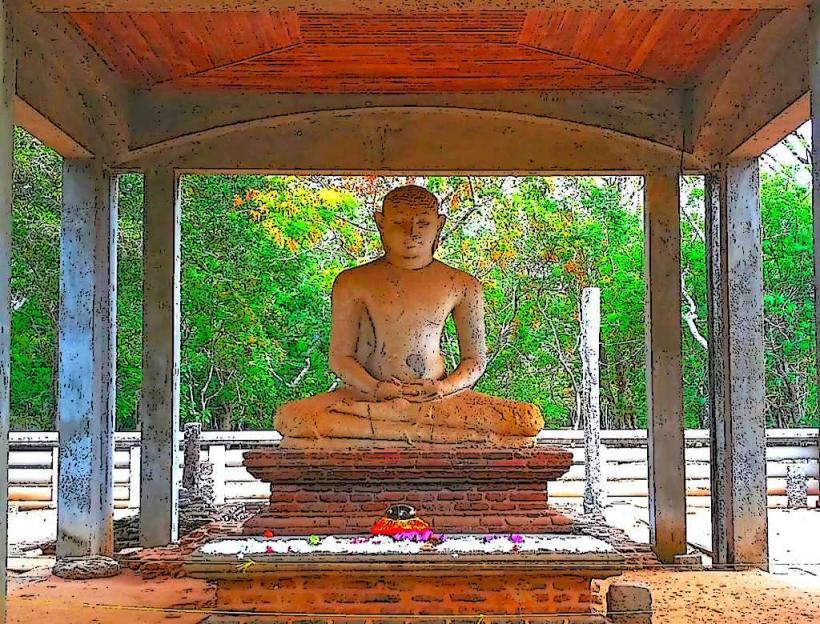Information
Landmark: Jethawanaramaya StupaCity: Anuradhapura
Country: Sri Lanka
Continent: Asia
Jetavanaramaya Stupa, Anuradhapura
The Jetavanaramaya Stupa is one of the most remarkable and awe-inspiring monuments in Sri Lanka, located in the ancient city of Anuradhapura. It is the third-largest stupa in the world and one of the most important religious and architectural landmarks in the country. The stupa’s sheer size, historical significance, and association with Buddhism make it a key site for both pilgrims and tourists.
Overview
- Name: Jetavanaramaya Stupa
- Location: Anuradhapura, North Central Province, Sri Lanka
- Type: Buddhist Stupa
- Religious Significance: The stupa is considered one of the holiest sites in Sri Lanka, housing relics of the Buddha.
- Period of Construction: 3rd century CE
- Height: Originally 120 meters (394 feet), current height after restoration is approximately 70 meters (230 feet)
- Diameter: 95 meters (312 feet) at the base
Historical and Religious Significance
Construction by King Mahasena:
- The Jetavanaramaya Stupa was built by King Mahasena (ruled from 273–301 CE) in the 3rd century CE. King Mahasena constructed the stupa as part of his efforts to promote Buddhism and consolidate his reign. The stupa was designed to house a relic of the Buddha, making it an important religious site for Buddhist worship and pilgrimage.
- It was originally named Jetavana after the Jetavana Monastery, which was one of the most famous Buddhist monasteries in ancient India, associated with the Buddha's disciple, Mahakasyapa.
Role in Sri Lankan Buddhism:
- The Jetavanaramaya Stupa is one of the most sacred Buddhist monuments in Sri Lanka. It is believed to house a relic of the Buddha, further solidifying its religious importance. The stupa was a significant center for Buddhist scholarship, meditation, and rituals, attracting monks and scholars from around the region.
- The stupa and its surrounding monastery complex were key in the development of Theravada Buddhism in Sri Lanka, contributing to the spread of Buddhist teachings throughout Southeast Asia.
Largest Stupa in Sri Lanka:
- At the time of its construction, the Jetavanaramaya Stupa was the tallest stupa in the world, with an original height of about 120 meters (394 feet). Its massive size and grandeur were intended to demonstrate the power and devotion of King Mahasena to Buddhism. Even after several centuries and restorations, it remains one of the largest structures in Sri Lanka and the third-largest stupa in the world.
Architectural Features
Massive Size:
- The Jetavanaramaya Stupa is one of the largest and most impressive stupas in the world. With an original height of 120 meters, it was taller than many other stupas built in ancient times. Although it has since lost some height due to natural wear and restoration efforts, it still stands at approximately 70 meters (230 feet) today.
- The stupa has a diameter of 95 meters (312 feet) at the base, making it one of the widest stupas as well.
Design and Structure:
- The stupa follows the traditional Sri Lankan stupa design, characterized by a large domed structure, which represents the Buddha’s enlightenment and the path to nirvana. The circular base of the stupa symbolizes the universe, and the dome represents the Buddha’s spiritual journey.
- The stupa is surrounded by a series of stone pillars, some of which are still standing today. These pillars are believed to have supported the ancient monastic complex that once surrounded the stupa.
- The gateway to the stupa is marked by a set of entrance steps, which would have been used by pilgrims to approach the stupa and offer prayers or make offerings.
Ancient Building Techniques:
- The construction of the Jetavanaramaya Stupa was an extraordinary feat of engineering. Ancient brickwork techniques were used to build the stupa, with bricks of uniform size and precision. The stupa’s core was made using small bricks, and the outer surface was finished with large stones, which were carefully shaped and fitted together.
- The internal structure of the stupa was designed to house the Buddha’s relic, as well as serve as a repository for religious manuscripts and other sacred Buddhist texts.
Cultural and Religious Importance
Sacred Relic:
- The Jetavanaramaya Stupa is believed to house a relic of the Buddha, making it one of the most sacred Buddhist sites in Sri Lanka. This relic is thought to have been brought to Sri Lanka by early missionaries and was enshrined in the stupa, symbolizing the Buddha’s presence and his spiritual teachings.
Pilgrimage Site:
- Like many other stupas in Sri Lanka, the Jetavanaramaya Stupa is a popular pilgrimage destination. Pilgrims from across Sri Lanka, as well as from other Buddhist countries, visit the stupa to pay their respects to the Buddha and to seek spiritual merit. Special religious ceremonies and rituals are held at the stupa, especially during Poya days (full moon days), which are considered auspicious days for Buddhist worship.
Cultural Legacy:
- The Jetavanaramaya Stupa is not only an important religious monument but also an essential part of Sri Lanka’s cultural heritage. The stupa’s size, beauty, and historical importance make it an architectural masterpiece. It represents the spiritual devotion of ancient Sri Lankan kings and the country’s deep connection to Buddhist principles.
Restoration and Preservation
Restoration Efforts:
- Over the centuries, the Jetavanaramaya Stupa has been subjected to natural wear, earthquakes, and other external factors, causing some damage to the structure. In modern times, extensive restoration efforts have been carried out to preserve the stupa and maintain its grandeur.
- The restoration of the stupa has been undertaken by both the Sri Lankan government and various Buddhist organizations, and the stupa has undergone several phases of conservation to ensure that it remains a prominent religious site for future generations.
Current Preservation:
- Today, the Jetavanaramaya Stupa stands as a symbol of Sri Lanka’s Buddhist heritage and is carefully preserved for future generations. The stupa is regularly cleaned, maintained, and protected by religious and government authorities to keep it intact as a sacred and cultural landmark.
Visitor Experience
Access:
- The Jetavanaramaya Stupa is located within the Sacred City of Anuradhapura, a UNESCO World Heritage Site. It is easily accessible to visitors who wish to explore the historical ruins of Anuradhapura, which also include other famous sites such as the Sri Maha Bodhi Tree and the Ruwanwelisaya Stupa.
Religious Etiquette:
- Visitors are encouraged to dress modestly and remove their shoes before entering the sacred area of the stupa. It is customary to walk clockwise around the stupa and to engage in meditation or prayer while at the site. Visitors should also maintain a peaceful and respectful attitude during their visit.
Touring the Complex:
- Visitors can explore the Jetavanaramaya Stupa and its surrounding ruins, including the remnants of monastic buildings, stone pillars, and meditation halls. The archaeological site offers valuable insights into the ancient Buddhist monastic life and the scale of religious life during the time of King Mahasena.
Nearby Attractions
Ruwanwelisaya Stupa (Approx. 2 km):
- The Ruwanwelisaya Stupa is another iconic stupa in Anuradhapura, known for its grand design and religious significance. It is one of the largest stupas in Sri Lanka and houses sacred relics of the Buddha.
Sri Maha Bodhi Tree (Approx. 2 km):
- The Sri Maha Bodhi Tree is one of the oldest living trees in the world and is a highly sacred site for Buddhists. It is believed to be a sapling from the original Bodhi Tree in India, under which the Buddha attained enlightenment.
Abhayagiri Stupa (Approx. 1 km):
- The Abhayagiri Stupa is another massive stupa located near the Jetavanaramaya Stupa. It is also an important religious site with significant historical and cultural value.
Conclusion
The Jetavanaramaya Stupa is one of the most impressive and significant religious monuments in Sri Lanka and the world. Its massive size, historical importance, and association with the Buddha’s relics make it a key destination for pilgrims and historians alike. The stupa continues to serve as a center of Buddhist worship and a symbol of Sri Lanka’s rich cultural heritage, attracting visitors from all around the world to marvel at its grandeur and spiritual significance.

